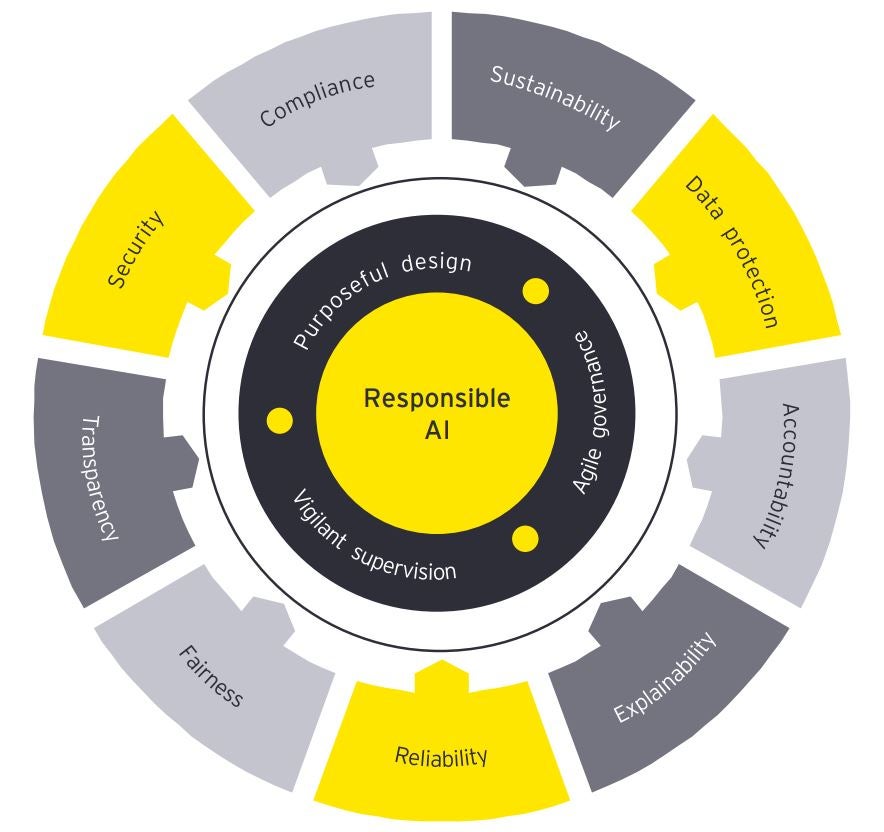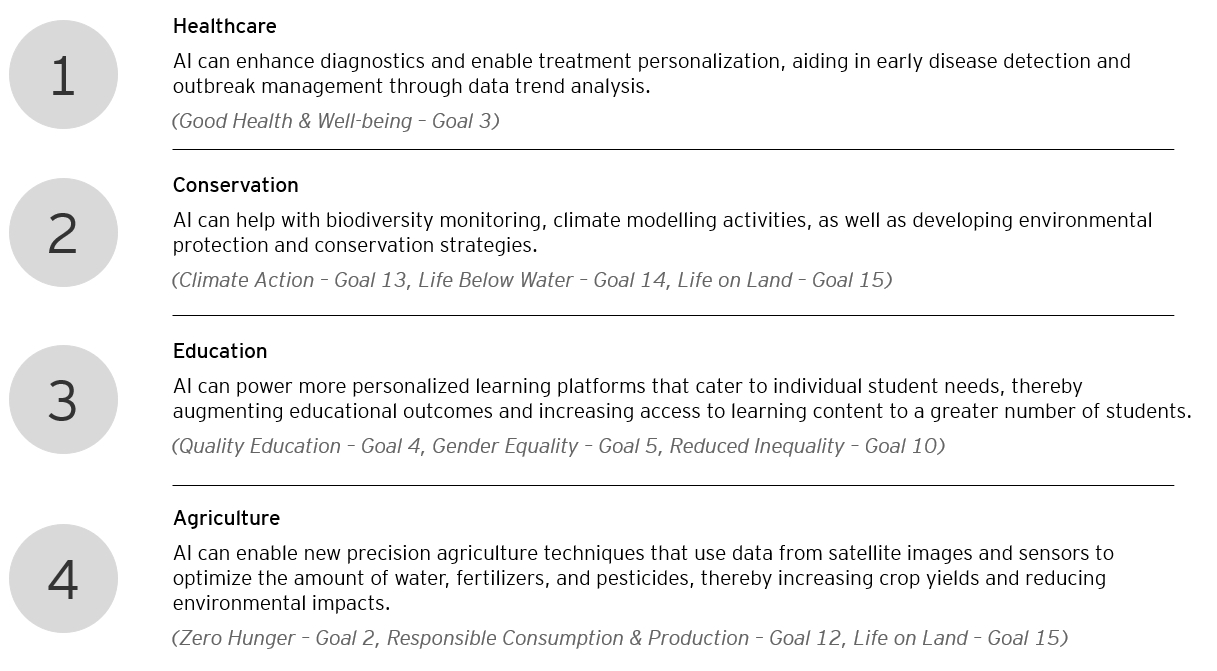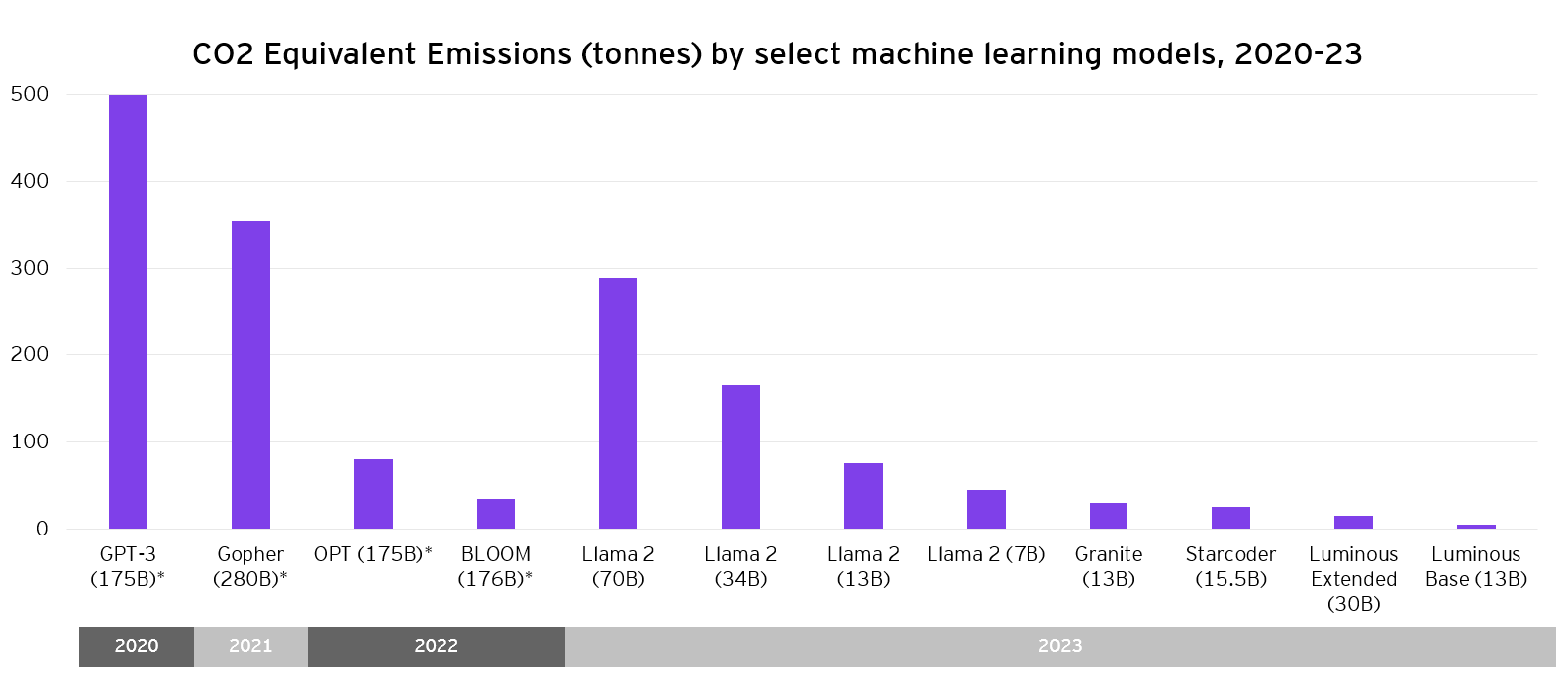EY refers to the global organization, and may refer to one or more, of the member firms of Ernst & Young Global Limited, each of which is a separate legal entity. Ernst & Young Global Limited, a UK company limited by guarantee, does not provide services to clients.

This article was the result of research compiled by members of the Sustainable AI Working Group at EY, including Volha Litvinets, Kevin Franco, Mira Pijselman, Cong Li, Rosa Eggink, Angèle Schmidt, and Andras Vekassy.
This article explores the environmental impact of artificial intelligence (AI) and discusses opportunities, current legislation, and ways organizations can make AI usage more sustainable.
In brief:
- Artificial intelligence (AI) presents a dilemma by both enabling novel use cases that may lessen environmental impacts and risking a further acceleration of environmental harm due to its growing resource intensiveness.
- Existing frameworks and legislation often fall short of providing comprehensive guidance for companies to assess and integrate AI-related sustainability measures.
- Sustainability assessments and disclosures for AI systems remain complex due to existing methods that do not fully account for the holistic environmental impacts of the AI supply chain.
The concept of sustainability was notably articulated in the 1987 Brundtland Report published by the United Nations, which defined sustainable development as “development that meets the needs of the present without compromising the ability of future generations to meet their own needs.” This definition underscores the importance of balancing current demands with resource preservation for the future, a principle increasingly relevant in the age of artificial intelligence (AI).
Today, AI is marked by a distinct duality: it drives efficiencies and fosters innovative solutions to complex environmental and social issues, while also presenting amplified resource demands beginning to rival the energy consumption requirements of whole nations.
This article is the first in the EY SustAInable series, a collection of articles, surveys, and op-eds focused on exploring the intersection of AI and sustainability. At EY, we have included sustainability as a core component of our Responsible AI Framework and corresponding Responsible AI Principles. We are committed to embedding sustainability considerations into our approach to developing and procuring AI systems and in how we work with clients on AI-related engagements.

Responsible AI Principles definition, Sustainability: considerations of the impacts of technology are embedded throughout the AI lifecycle to promote physical, social, economic, and planetary well-being.
To view our total set of Responsible AI Principles, click here.
In this first iteration of the series, we focus distinctly on the environmental challenges and opportunities posed by AI and its rapid commercialization by considering three questions:
- How significant are the environmental impacts of generative AI (GenAI), and what specific challenges do they pose?
- What current frameworks and legislation exist to guide the sustainability of AI technologies, and what gaps remain in these approaches?
- In what practical ways can organizations integrate sustainability into their AI development and deployment strategies to mitigate environmental impacts?
Balancing AI’s sustainability gains and risks
As AI becomes more ubiquitous across sectors and regions, a variety of environmentally focused use cases have emerged. For example, consider the AI for Good movement championed by organizations including the United Nations. It focuses on the ways in which AI can be leveraged to assist in achieving the Sustainable Development Goals (SDGs), many of which center on the environmental aspects of sustainability (e.g., Goal 13).[1] In fact, by 2030, the European Parliament’s Think Tank estimates that AI could be harnessed to reduce global greenhouse gas emissions by 1.5-4%,[2] which would directly assist in working toward the targets set out in Goal 13.
During the recent AI for Good Global Summit 2024, over 80 demonstrations showcased AI’s potential in advancing space exploration and environmental sustainability, highlighting innovative applications like AI-driven weather prediction, water management, and waste monitoring technologies.
How AI for Good initiatives align to the United Nations’ Sustainable Development Goals:

United Nations’ Sustainable Development Goals: specific AI initiatives that align with the United Nations’ SDGs. These initiatives demonstrate AI's transformative impact across various sectors including healthcare, environmental conservation, education, disaster response, and agriculture, showcasing how AI technologies are advancing global sustainability efforts and enhancing societal benefits.
However, with great opportunity comes a substantial responsibility to manage AI's associated impacts, as the technology can be used to influence the environment, society, and economy. The supply chain associated with AI systems and their continued maintenance carries a significant environmental cost, including high energy consumption demands associated with training and maintaining advanced machine learning models. These impacts span the entire lifecycle of AI systems, from their development through to their deployment and continued operation and maintenance.
AI’s environmental footprint – key dimensions
- Energy consumption: AI models, due to their complexity, require substantial computational power. This demand results in high energy use, particularly during the training phase, which can be extensive for more sophisticated models. It's worth pointing out that the energy consumed during model training is typically dwarfed by the energy consumption associated with inference. Notably, the type of model(s) selected for a given use case can influence the overall environmental footprint of an AI system. Deep learning, natural language processing (NLP), and GenAI models, for instance, are more energy-intensive than simpler classification models.
- Greenhouse gas (GHG) emissions: The significant energy required for powering AI systems often leads to considerable GHG emissions, especially if the energy is sourced from non-renewable power plants.
- Water consumption: Large data centres – core infrastructure required to train and deploy increasingly advanced AI models – require cooling systems that consume vast amounts of water to prevent overheating and sustain performance. This usage can exacerbate water scarcity in regions already vulnerable to such stress.
- Hardware and e-waste: The hardware underlying AI, including servers, GPUs, and other specialized equipment also has an environmental impact. The production and disposal of these devices involve significant resource extraction, manufacturing emissions, and electronic waste, which can lead to environmental degradation and pollution.
Large language models (LLMs), a form of GenAI, feature tens to hundreds of billions of parameters and are trained on vast datasets to produce content. However, the environmental impact of such models is considerable.

LLM Parameters and carbon emissions: The growth in LLM parameters from 100 million to 500 billion reflects the increasing complexity and computational demands of these models. The carbon emission graph shows substantial CO2 equivalent emissions for training various LLMs. Source: Stanford AI Index Report, 2024.
Research regarding the ways in which the AI supply chain can be made to be more environmentally efficient is ongoing. Strategies to address the environmental challenges might include optimizing the energy efficiency of AI systems, using renewable energy sources for power, and developing more water-efficient cooling technologies for data centers. As an example, deploying large AI models on edge devices — like smartphones, smart speakers, and wearables — provides a more sustainable alternative that has become increasingly popular. Edge devices, constrained by less computational power, cannot run large models with billions of parameters. This limitation reduces both the cost of operations and the energy used for data transfers in cloud computing. Thus, models operated on edge devices are often far more energy-efficient than those on cloud systems, significantly lowering their environmental impact.
Outside of training, there are further concerns associated with GenAI from an end user perspective regarding the environmental costs of ongoing usage and operation of such tools. For example, image generation is more energy and carbon intensive than text generation and large language models that are general purpose by nature are more energy intensive than small language models designed for specific tasks.[3]
Ongoing research at the intersection of AI and sustainability paired with heightened intentionality about when, why, and how organizations are using GenAI will be increasingly important to enabling a sustainability AI ecosystem. In the next section, we turn to a consideration of legislative frameworks from which inspiration may be drawn in resolving AI’s sustainability paradox.
Sustaining sustainability – existing legislation
In understanding the dual nature of AI, it is important to examine how AI development and usage aligns with broader sustainability efforts. What guidance is available to guide the sustainable development and application of AI technologies? How can governments and global institutions confirm that AI systems contribute positively to the SDGs?
To start, let’s consider the European Commission's Corporate Sustainability Reporting Directive (CSRD). The CSRD, which is effective from 5 January 2023, expands the scope of environmental and social reporting. From 2024, a wider range of companies, including non-EU firms making over EUR 150 million in the EU, must adhere to the European Sustainability Reporting Standards (ESRS).
To assist companies in their environmental, social, and governance (ESG) reporting, several frameworks have been developed. For instance, the Carbon Disclosure Project (CDP) helps companies share environmental data, covering risk management, environmental targets, and strategic planning. Similarly, the Global Reporting Initiative (GRI) offers a standardized framework for reporting on a broad spectrum of ESG issues (e.g. greenhouse gas emissions, labor practices, human rights, and community impact), which enhances transparency and management practices globally.
Although these reporting frameworks focus on the broader impact of organizations, they should implicitly include a consideration of AI systems and emphasize the importance of understanding and accounting for AI's specific impact within these ESG disclosures.
We also have the EU AI Act – Europe’s landmark AI regulation – which touches on sustainability considerations associated with the design, training, and use of AI. The way in which the environmental sustainability of AI ought to be assessed and minimised will be further clarified by the AI Office and individual Member States in forthcoming codes of conduct and harmonized standards.
Meanwhile, the National Institute of Standards and Technology (NIST) framework for assessing the sustainability of AI includes evaluating the environmental impacts and management practices of model training. It focuses on establishing measurable sustainability baselines and assessing AI systems' trustworthiness by documenting key performance indicators like computational resource usage and operational carbon footprint.
While new regulations and standards aim to mitigate AI's environmental impacts, they lack clarity on how to measure and allocate energy usage across the complex, multi-stakeholder AI ecosystem. To conform to standards and leading practice, there is a critical need for operational frameworks and methodologies with which to assess and measure sustainability risks posed by AI.
Practical considerations for sustainability leaders
To put it simply: the accurate assessment of AI’s environmental impacts is challenging. It requires the development of robust measurement methodologies, a clear allocation of accountability for sustainability impacts across stakeholders involved in the AI supply chain, and alignment on what ‘good’ looks like with respect to mitigations. When it comes to GenAI, open-source tools[4] are beginning to emerge to address some of the measurement challenges associated with the environmental impacts of LLMs. These tools generally consider 4 main factors to estimate carbon emissions:
- Training duration of the model, with direct influence on the number of computational operations needed.
- Energy efficiency of GPUs, which affect the amount of energy consumed during training.
- Hosting location of datacenter, which impacts the amount of CO₂ emitted per kilowatt-hour of electricity used.
- Potential offsets by the service provider, which could partially neutralize the environmental impacts of training.
However, concerns remain as to the precision of these tools. For example:
- There is doubt as to data availability and accuracy, especially with respect to the energy efficiency of GPUs and the carbon intensity of data centres.
- There is an outsized focus on model training, which means that emissions generated during the model fine-tuning or inference phases are not always considered.
- Tools tend to be designed for classical machine learning developers, who have detailed technical information or direct access to a model’s code. This could be a constraint for GenAI developers, who may only have application programming interface (API) access to the foundation models.
- There is a limited focus on Scope 1 & 2 emissions, as opposed to Scope 3 emissions.
Not to mention that while LLMs and GenAI more broadly have taken up a significant amount of public consciousness as of late, there is still a need to understand, measure, and report on the sustainability impacts of classical, discriminative AI systems as well.
To enable a more holistic approach to measuring the sustainability impacts of AI systems, sustainability leaders should consider the following dimensions:
- Compute operations: Estimate computational complexity by counting operations or using the model parameters and tokens for vendor-hosted models.
- Electricity usage: Determine power consumption based on hardware efficiency, with data available from cloud providers.
- Carbon footprint: Calculate direct carbon emissions using the data center's carbon intensity or its Carbon Usage Effectiveness (CUE), noting the challenges in quantifying indirect emissions.
- Water usage: Assess water consumption through on-site Water Usage Effectiveness (WUE) and off-site impacts via Power Usage Effectiveness (PUE).
EY teams assist clients in managing sustainability challenges posed by AI across its lifecycle, from development through to deployment and monitoring. EY’s approach not only addresses direct and indirect emissions but also offers methodologies for reducing energy consumption and optimizing resource use. By integrating such practices, businesses can enhance their sustainability reporting and make more informed decisions that align with global sustainability goals.
EY AI + Sustainability Strategy
Corporate Regulatory Reporting
[Internal] EY as client zero ‘our own sustainability journey’
- Sustainability Insights Bot.
- ESG IP Gen-AI POC.
[External] Disclosure standards and frameworks, including CSRD.
- Gen AI for Sustainability Directives
- Smart Decarb
Role of AI in Risk Management
- Green Washing Intelligence and Insight: Green Washing Compass
- Geospatial capabilities/ weather science for climate mitigation and adaptation efforts — Space Tech
- Coastal Resilience x AI: EY Open Science Data Challenge Platform
- Just transition: human rights risk identification and supply chain:
- AI for risk management
- AI for Green Procurement + scope 3 management.
Resource Stewardship
- EY.ai Workforce (IBM Watson Orchestrate)
- Energy efficient data centres and electricity usage
- Waste management (e-waste) and circularity of end user compute
- Sustainable Infrastructure (including Predictive Maintenance)
- Decentralized water systems (water usage, scarcity) — Microsoft water management co-pilot.
Closing Remarks
Amid a variety of promising AI use cases targeting climate change mitigation and environmental good, the growth of the AI ecosystem and rapidly scaling complexity have exacerbated existing environmental challenges inherent to technology adoption. While legislative frameworks are starting to be established to integrate sustainability considerations into how AI is developed, operated, and used, significant gaps remain that challenge the extent to which organizations can practically comply with these standards. This uncertainty is especially pronounced in the methods available for measuring AI's environmental impact, where standardized metrics and clear guidelines are lacking.
The absence of universally accepted measurement techniques makes it difficult for organizations to assess and communicate their sustainability efforts accurately. Further, current frameworks do not provide sufficient detail on the specific actions required to minimize the ecological footprint of AI operations.
To push the intersection between AI and sustainability forward, we propose a more holistic approach towards the measurement of AI’s environmental impacts to consider the dimensions of compute operations, electricity usage, carbon footprint, and water usage.
Contact us to continue a conversation:
Summary
This article delves into the sustainability challenges and opportunities posed by artificial intelligence (AI), emphasizing the environmental impacts of generative AI (GenAI) and large language models. It highlights a dual perspective: while AI offers innovative solutions for pressing global issues, it also introduces substantial energy demands, water consumption, greenhouse gas emissions, and e-waste concerns. The article, part of EY’s SustAInable series, explores strategies for mitigating these environmental impacts, such as adopting more efficient AI development practices, leveraging edge computing, and embedding sustainability into AI-related business operations.
Related articles
How LUCY pioneers more sustainable flying
LUCY aims to be the first airline that offers sustainable and affordable flights in Europe


